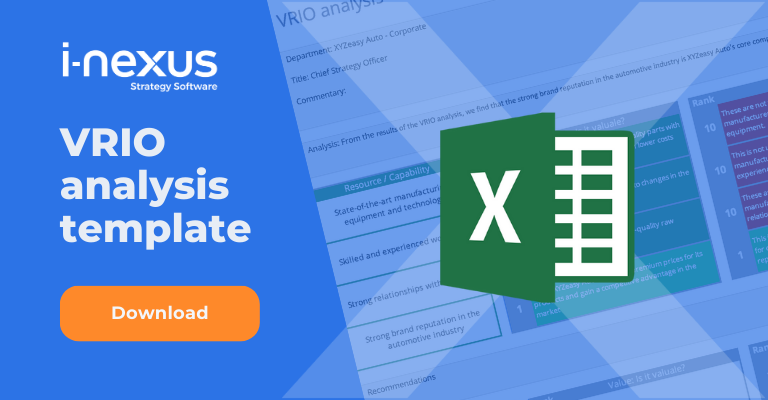Get to know five commonly used frameworks: VRIO, SWOT, Value Chain, Resource-Based View (RBV), and PESTEL, how they offer a unique perspective on a company's internal and external environment and can be used in different stages of the strategy creation process.
While several strategy creation tools are available in your arsenal, there are key differences to know. In this blog, we'll run through the key characteristics of five core models, each offering value in analyzing and modeling your internal and external environment on the way to creating your strategy.
Read on to learn how VRIO, SWOT, Value Chain, RBV, and PESTEL can be used alongside one another to help you generate effective strategies.
VRIO v SWOT
VRIO and SWOT analysis are both frameworks that can be used to analyze a firm's internal and external environment. However, they have some key differences:
-
Focus
VRIO is an acronym for value, rarity, inimitability, and organization. It is focused on analyzing a firm's internal resources and capabilities to determine the potential for sustained competitive advantage.
While SWOT analysis (Strengths, Weaknesses, Opportunities, and Threats) is a framework used to analyze a firm's internal and external environment and identify its internal strengths and weaknesses and external opportunities and threats. -
Purpose
The primary purpose of VRIO analysis is to identify resources and capabilities that create value, are rare, difficult to imitate, and well-organized.
The primary purpose of SWOT analysis is to identify factors that may positively or negatively impact a firm's performance. -
Scope
VRIO analysis focuses on a firm's internal resources and capabilities, whereas SWOT analysis looks at internal and external factors. -
Outcome
VRIO analysis helps a firm identify resources and capabilities that can be leveraged for sustained competitive advantage, whereas SWOT analysis helps a firm identify opportunities and threats and develop a strategy accordingly.
While VRIO and SWOT analysis are useful tools for analyzing a firm's competitive position, VRIO is more focused on a firm's internal resources and capabilities. Its goal is to help firms identify resources and capabilities that can be leveraged for sustained competitive advantage.
On the other hand, SWOT analysis is a broader framework that looks at internal and external factors. Its goal is to help firms identify opportunities and threats and develop a strategy accordingly.
VRIO v Value Chain Analysis
VRIO and value chain analysis can analyze a firm's internal resources and capabilities and determine its potential for sustained competitive advantage.
However, they have different focuses and approaches:
-
Focus
VRIO focuses on four key characteristics of a resource or capability - value, rarity, inimitability, and organization - to determine whether it can be leveraged for sustained competitive advantage.
On the other hand, value chain analysis focuses on analyzing a firm's different activities and how they contribute to creating value for the customer. -
Level of Analysis
VRIO framework is more micro-level, looking at individual resources and capabilities, whereas value chain analysis takes a more macro-level approach, looking at how the firm's activities collectively contribute to creating value for the customer. -
Emphasis on Competitive Advantage
VRIO analysis is focused on identifying resources and capabilities that create value, are rare, difficult to imitate, and well-organized.
While the value chain analysis is more focused on identifying how the firm's activities can be leveraged to create value and achieve a competitive advantage.
In terms of their interaction in a strategy creation process, VRIO and value chain analysis can complement each other by providing different perspectives on the firm's internal resources and capabilities.
A VRIO analysis can help identify specific resources and capabilities that can be leveraged for sustained competitive advantage, while a value chain analysis can help determine how the firm's activities can be leveraged to create value and achieve a competitive advantage.
Using both frameworks, a firm can gain a more comprehensive understanding of its internal resources and capabilities and how they can be leveraged to achieve sustained competitive advantage.
Additionally, VRIO and value chain analysis can also be used together to identify the firm's key activities that create value and that are hard to imitate by competitors; those activities can be considered as the firm's core competencies and can be further leveraged and invested in to create a sustainable competitive advantage.
VRIO v RBV
The Resource-Based View (RBV) and the VRIO framework share some similarities. Both focus on analyzing a firm's internal resources and capabilities to determine the potential for sustained competitive advantage.
However, there are also some critical differences between the two:
- Focus
The VRIO framework focuses on four critical characteristics of a resource or capability - value, rarity, inimitability, and organization - to determine whether it can be leveraged for sustained competitive advantage.
The RBV framework also looks at a firm's internal resources and capabilities, but it also considers the external environment and how resources and capabilities can be leveraged to achieve sustained competitive advantage. - Approach
VRIO takes a more micro-level approach, looking at individual resources and capabilities, whereas the RBV framework takes a more macro-level approach, looking at how the firm's resources and capabilities collectively contribute to its competitive advantage. - Emphasis on External Environment
VRIO Framework is more focused on internal resources and capabilities and doesn't give much emphasis on the external environment.
On the other hand, the RBV framework considers internal and external factors and how they interact to create sustained competitive advantage. - Emphasis on Competitive Advantage
VRIO analysis is focused on identifying resources and capabilities that create value, are rare, difficult to imitate, and well-organized.
While the RBV framework is more focused on identifying how resources and capabilities can be leveraged to achieve sustained competitive advantage.
The RBV and VRIO frameworks are useful tools for analyzing a firm's internal resources and capabilities and determining its potential for sustained competitive advantage.
However, the RBV framework takes a more holistic approach by considering both internal and external factors, whereas the VRIO framework is more focused on identifying specific resources and capabilities that can be leveraged for sustained competitive advantage.
VRIO v PESTEL
VRIO and PESTEL analysis are both essential tools for strategy creation in a company, but they focus on different aspects of the business environment.
- Focus
VRIO analysis focuses on the internal resources and capabilities of the organization, while PESTEL analysis looks at the external macro-environmental factors that impact the organization. - Approach
When conducting a VRIO analysis, a company will examine its internal resources, such as its production facilities, technology, and employees, and evaluate whether they are valuable, rare, inimitable, and well-organized.
The company can then use this information to identify its core competencies and develop a strategy that leverages them.
On the other hand, PESTEL analysis is a framework that helps companies analyze the external factors that may impact their business.
These external factors include Political, Economic, Sociocultural, Technological, Environmental, and Legal factors. By analyzing these factors, companies can anticipate changes in the business environment and develop strategies that are adaptable to these changes. - Value
VRIO and PESTEL analysis can provide valuable insights into a company's internal and external environment. The two approaches can be used to comprehensively understand the company's strengths and weaknesses and opportunities and threats.
By using VRIO analysis to identify internal resources and capabilities and PESTEL analysis to understand the external macro-environmental factors, companies can develop strategies that consider both internal and external factors and create a sustainable competitive advantage.
Which tools should you use while modeling your environment?
VRIO, SWOT, Value Chain, Resource-Based View (RBV), and PESTEL frameworks are all powerful tools that can be used to analyze a company's internal and external environment. Each of these frameworks offers a unique perspective and can be used in different stages of the strategy creation process.
The VRIO framework is beneficial for identifying a company's valuable, rare, inimitable, and organization-specific resources and capabilities.
SWOT is a simple and widely used tool for identifying a company's strengths, weaknesses, opportunities, and threats.
Value Chain analysis helps to understand the different activities that go into creating a product or service and how they relate to one another.
The Resource-Based View (RBV) takes a holistic approach to analyze a company's resources and capabilities to understand its competitive advantage. PESTEL analysis examines the external macro-environment factors that can impact a company.
In choosing which framework to use, it's essential to consider your analysis's specific context and goals.
Combining different frameworks can often be more effective than relying on one alone.
Each framework has its strengths and limitations, so it's essential to understand how to use them effectively to gain valuable insights into your company's strengths and weaknesses and develop a solid strategy for the future.
Complete your VRIO and SWOT analysis with i-nexus
Creating your VRIO and SWOT analyses have never been easier with this Excel template, available to download by clicking the link below.
Click below to download your templates today.
Learn more about strategy creation
Take the next steps in your journey by exploring our strategy execution resource hub or any of the below:
- Key to strategy execution eBook: Read how companies like Danaher and HP have mastered strategy execution and what you can learn from them.
- What does it mean to be Business Agile?: Leap into the future of strategic planning and execution with this fascinating insight.
- How AI and Machine-Assisted Learning will help strategy execution: As Artificial Intelligence becomes a mainstay in our lives, read how AI and machine-assisted learning will evolve to support your strategy execution.
About the author
James Milsom is Head of Marketing at i-nexus.
As Head of Marketing, he aims to raise awareness and understanding of enterprises' challenges in delivering strategic objectives and transformation amidst changing markets and the obstacles traditional tools and methods present leaders.
If you’d like to talk more about strategy, reach out to James at james.milsom@i-nexus.com or connect with him on LinkedIn for the latest insights.




.jpg?width=352&name=KPIs%20(3).jpg)